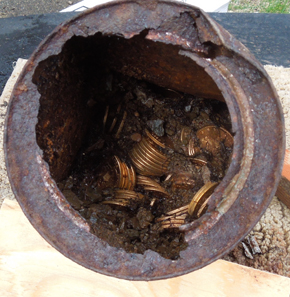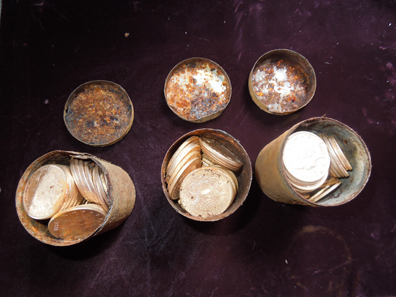by Björn Schöpe
March 6, 2014 – Last week the international press published a story of an enormous gold treasure. It sounds like a fairy tale. A couple – a man and woman who wish to remain anonymous and therefore call themselves just John and Mary – walk their dog on their estate in North Carolina and stumble over a rusty can. Later the two people in their mid-forties state that they saw something there previously but did not pay attention to the object. Apparently a striking stone served as a mark the treasure being located exactly ten paces away from it. Maybe due to a soil erosion one can was pushed out so far as it could be seen clearly then.
The cans were filled up with gold coins. Photograph: Kagin’s.
Anyway, John and Mary carry the heavy container home. There they become aware of the can being filled up with gold coins. And indeed they find another seven cans at the finding spot. At the first moment they just don’t know what to do about it and hence they hide the stuff in an ice-chest under wood like the old-timers would do it and contact a coin expert.
The coins were stored chronologically. Photograph: Kagin’s.
Kagin’s Inc. immediately notes that the coins are worth a fortune. The treasure is composed of 1,400 $20 Double Eagle coins, fifty $10 coins, and four $5 coins all made of gold. The coins were minted between 1847 and 1894 and stored away chronologically which indicates that someone may have saved them up over a longer period.
The coins are in extremely well preserved condition. Around a third of them seems not to have circulated at all, and some of the coins may be arguably the best preserved specimen known of their type like for example an 1866-S $20 without motto. Only few coins of that year lack the motto of the USA ‘In God We Trust’, and this coin alone is estimated at nearly 1 million US dollars. The whole treasure is expected to realise over 10 million US dollars making it thus the most precious treasure ever found in the USA.
The hoard came up in spring 2013 already. The couple that found it used to call the finding spot Saddle Ridge from which the treasure soon took over its nickname Saddle Ridge Hoard. In the following months Kagin’s David McCarthy cleaned all the coins until his fingers bled, as he said. Now the grading company PCGS has graded and authenticated all the coins. In February 2014 Kagin – as official representative of the finders – went public. A selection of coins from the treasure was displayed at the American Numismatic Association National Money Show in Atlanta where visitors could lionise the objects. Don Kagin compares the treasure to the proverbial pot of gold at the end of the rainbow. No doubt, it is clearly a sensational finding.
The finders, however, stay calm and wish to carry on with their lives as usual. Now the freelancers can pay their debts and plan to donate money, help their families and the local poor. And some coins they would like to keep as souvenirs. Kagin has concluded an exclusive arrangement with Amazon Collectibles. The online giant will sell approximately 90 percent of the coins. We will see if the coins will be presented in a way so lasting and academically serious as we would expect it from a traditional auction catalogue.
But then, another question remains: where comes the treasure from anyway? And linked to this question: whom does it belong to?
The finders and their lawyers state that they have done intensive research but the only thing they could think about was that the coins were probably hidden by a mint employee. Following this result the money belongs to the finders.
However, soon much more specific hypotheses circulated in the media. A journalist came up with a feasible track by doing a simple Google search. In 1901 the San Francisco Mint accused one of their clerks, a certain Walter Dimmick, of having defrauded $30,000. This sum is said to have consisted of 1,500 Double Eagles. Although the money was never seized, on circumstantial evidence Dimmick was sentenced to nine years of prison.
The range of the years of issue, the excellent state of conservation, the chronological order, the finding spot, type and number of coins – all that fits very well with the peculated money from the time of the goldrush. But if these coins were really linked to the money from the San Francisco Mint, the claim of John and Mary would become rather feeble as the US Treasure Trove Laws are apparently quite vague. Some journalists already reckon that the finders would not consent to their names being made public because they don’t want to become a target of the US Department of the Treasury or of Dimmick’s descendants. Both parties could assert claims regarding the coins.
So we must wait to see who will get the fabulous sum of over $10 million. One thing is sure, anyway: collectors and numismatists have won the first prize since the treasure has enriched them immensely.
Addendum
In the meantime The US Mint has stated that they ‘do not have any information linking the Saddle Ridge Hoard coins to any thefts at any United States Mint facility’. So it appears that further investigations are required in order to establish the hoard’s origin. We will keep you informed when more reliable information will be available on that subject.
Kagin gives a detailed statement on the Saddle Ridge Treasure…
… and has published an exclusive interview with the finders.
An article on Mashable has revealed the story of Walter Dimmick.
Mail Online has also published a detailed article with many photographs.





